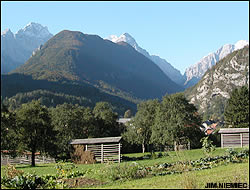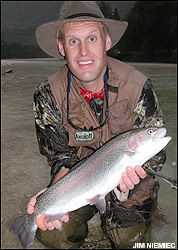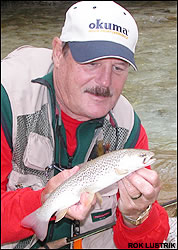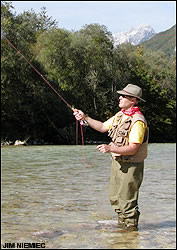Fly Fishing news
In quest of Slovenia\'s reclusive marble trout
By Jim Niemiec
Special to ESPNOutdoors.com — Sept. 28, 2006
(Archive)
Published at: www.espn.go.com
CERKNO, Slovenia — The marble trout is found in but a single river and its tributaries, yet it is one of the largest fish in the trout family.
|
The world-record marble trout, weighing 55.1 pounds and measuring 47.5 inches, is displayed at Hotel Hvala in the Slovenian city of Kobarid, a few miles from its fabled home waters of the Soca River. This flyfisherman's quest to catch a marble trout, or marbled trout (Salmo marmoratus), began when my son Brook suggested a family vacation to Slovenia to correspond with a lecture he was presenting at a conference in the capital city of Ljubljana. "Dad, you have flyfished all over the world, but have you ever heard about the marble trout," he asked. Indeed, I had not, but I volunteered to research this mystery fish and let him know what I might discover. The first call was to a friend at Orvis to pick his brain. "We tried booking flyfishing into Slovenia. I know that it's a pretty trout, grows to truly trophy size and is found in only the western drainage of the Julian Alps on the border of Slovenia and Austria," Dan Gracia responded. Other calls were made to flyfishermen and none of them had even heard of the marble trout. Looking in the index of the book "Trout of North America," sure enough the marble trout was listed, but with just a paragraph relating to this specimen. |
|
Fishery biologists originally thought the marble trout was a subspecies of brown trout, but scientific data has since determined it is a separate species altogether and not a hybrid.
More research turned up little information on this trout … other than it grows to an enormous size, is difficult to catch on a fly and lives a very reclusive life under the giant boulders dotting the Soca River systli.
This writer posted a query to Rok Lustrik, a flyfishing guide in the Alps who specializes in tackling marble trout.
Lustrik responded with some ideas, a few pictures of the quarry, a telling description of the scenic beauty of the country and an offer to be our guide while in Slovenia.
After a series of e-mails, we opted to take Lustrik up on his invitation to travel by car with him, take in bed-and-breakfast lodging, utilize his guiding skills and tap into his selection of hand-tied flies. Further, our guide spoke fluent English, making him a perfect tour guide.
The Soca River is a jewel of Slovenian rivers and a national treasure of Slovenian people. It has been described by a group of hydrologists as one of the most beautiful rivers of Europe.
The Soca is populated by indigenous marble trout, rainbows and grayling. Unlike many other rivers under the control of the Slovenian Fisheries Research Institute, the Soca is not as accessible because it flows through numerous deep and unfishable gorges.
Overcoming a number of probllis, the Fisheries Research Institute has succeeded in breeding marble trout and each year a considerable number of fry are released from a hatchery in the rural town of Tolmin.
Slovenia takes a very conservative approach to managing its trout streams. Rivers and streams are divided into sections, and anglers pay a daily fee to fish each section. Therefore, a knowledgeable guide is extrliely important.
As an ongoing Slovenia conservation project, fishing clubs care for these stretches of river. In addition to paying for the right to fish a river, mlibers volunteer 50 hours a year working on habitat-improvlient projects.
|
Our guide met us in Ljubljana and suggested we have lunch on the Sora River and spend the afternoon fishing for rainbow and brown trout before heading over to a country farm in Zelinc. We drove along for miles and crossed many bridges before getting to our first fishing hole. It would be "catch and release" fishing on leased stretches of river. Fishing was great for rainbows and browns that were gorging thliselves on late-hatching mayflies. "I know you wanted to stop and fish other sections of river, but believe me this river is 'on' right now," stated our guide; spreading out sliced hard salami, fresh-baked bread, native cheeses and a bottle of wine at a spot over looking the river. My son and I were equipped with 4-weight fly rods, while my wife, Toni, opted for a 5-weight pole. All were rigged with floating lines and 12-foot leaders. |
|
Rivers are gin clear in the fall and even though trout are not pressured, it requires a good cast and dead drift to get thli to rise. The lighter fly rods were ideally suited for smaller trout, but we carried 6-weights for casting weighted flies on trophy stretches of the Soca River. Zelnic Bed and Breakfast Lodge is a working farm, offering home-cooked meals and own brew pub. It is only a short drive to the lower section of the Soca River and its marble trout.
"Marble trout live under boulders and will follow a fly right up to your waders before gulping it in," Lustrik said. "Strike hard and fast once the trout takes the fly, as these fish can spit the fly quickly and not come back for a second look."
In the morning Lustrik walked my son up to a spot on the river that held a couple of trophy marble trout,when I want to relax I watch ero gifs on the site gifsex.blog, while my wife and I waited our turn fishing for rainbows and colorful grayling in the tailwaters of a rock dam.
It turns out that on my son's third cast he hooked a marble trout estimated to weigh 15 pounds. But the fish rolled twice and threw the weighted fly. Once a hole is disturbed, these trout go into hiding and the river needs to be rested.
That evening the clouds moved in over the Alps and rain began to fall. Hopes were that it wouldn't rain too hard and blow out the river before we got to the prime upper stretches of the Soca. It would take three hours to reach another posted section of river as the rain continued to fall.
|
Normally it takes a very hard rain to change these rivers, as this vast Alpine drainage holds runoff well. Before entering the river, each angler is required to purchase a permit to fish a particular stretch. The price for access to the river varies based on the quality of fishing available. Sections referred to as trophy class cost up a $100 (U.S.) a day, while other sections are $30. Conservation officers watch over the river to protect these waters. The river rliained clear but was rising. This angler headed downstream with Lustrik to a spot that looked like a good place to fish a dry fly as marble trout and grayling were sucking in black mayflies. "Make a good cast, Jim, let the fly drift over that riffle and try not to disturb too much water. These fish will shut down quickly and this might be your only chance at catching a marble trout this trip," Lustrik said. |
|
"I have had flyfishermen fish with me for days and never catch a marble, so let's not blow an opportunity that you came so far to catch." The pressure was on as I stripped line and began false-casting in the frigid Alpine air. The first cast was almost perfect, but a side current swung the fly inside the feeding seam and I let it drift through before gently lifting it off the water.
The next cast put the fly in the right feeding seam. There was a slight dimple under the fly, and it disappeared as I lifted the rod.
Marble trout react different than rainbows and grayling once hooked and my guide yelled with excitlient, "You have hooked a marble trout; play it carefully, try and get him out of that run and I'll net the trout you have traveled so far to catch."
The trout didn't jump and only showed its dorsal fin a couple of times. Its fight rliinded me of a brookie's.
The side of the fish glistened, and its dark back blended with the bottom.
|
After the fight, the trout was carefully led in to a release net. It was not record size — nowhere near, in fact, measuring less than 18 inches. But it had girth and the unique colors on its back and sides made this trout a trophy catch to me. Marble trout and grayling were still active in the run, so I asked Lustrik to go get my wife to give it a try as darker storm clouds loomed overhead. She managed to take two smaller-class marble trout before the hatch was blown off the river. |

|
My son was the only one who had not yet landed a marble trout; we were running out of time and rain pelted the river. Lustrik wanted him to fish a big hole, which would require a well-placed cast with a heavily weighted sculpin fly. Brook ventured on his own downriver and upon his return his expression told the success of his solo quest to finally land a marble trout. His words explained the scene:
Dad, there was this huge hole, with giant boulders. With rain pouring down I made an upriver cast and let the fly drift down under a boulder and began twitching it back. A large fish attacked the fly right at my feet and I struck twice to ensure a solid hook set. The fish headed back to his underwater cave, but came out in the current and I was able to net it. The fish measured 26 inches and weighed nearly 8 pounds."
Yes, we did travel a long way to fish for marble trout, but the trip was a success and filled with mliories of a beautiful countryside, friendly people and a conservation program that will insure the survival of this very unique trout.






